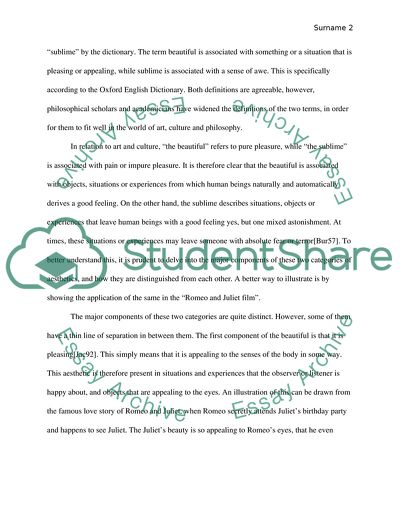Cite this document
(Culture and Philosophy: Aesthetics - the Beautiful and the Sublime Literature review, n.d.)
Culture and Philosophy: Aesthetics - the Beautiful and the Sublime Literature review. https://studentshare.org/philosophy/1843842-topic-this-course-focuses-on-some-of-the-definitions-functions-and-challenges-of-aesthetic-categories-that-emerge-in-the-context-of-cinema-and-more-generally-in-artistic-engagements-with-culture-and-philosophy-in-our-studies-we-have-encountered-the
Culture and Philosophy: Aesthetics - the Beautiful and the Sublime Literature review. https://studentshare.org/philosophy/1843842-topic-this-course-focuses-on-some-of-the-definitions-functions-and-challenges-of-aesthetic-categories-that-emerge-in-the-context-of-cinema-and-more-generally-in-artistic-engagements-with-culture-and-philosophy-in-our-studies-we-have-encountered-the
(Culture and Philosophy: Aesthetics - the Beautiful and the Sublime Literature Review)
Culture and Philosophy: Aesthetics - the Beautiful and the Sublime Literature Review. https://studentshare.org/philosophy/1843842-topic-this-course-focuses-on-some-of-the-definitions-functions-and-challenges-of-aesthetic-categories-that-emerge-in-the-context-of-cinema-and-more-generally-in-artistic-engagements-with-culture-and-philosophy-in-our-studies-we-have-encountered-the.
Culture and Philosophy: Aesthetics - the Beautiful and the Sublime Literature Review. https://studentshare.org/philosophy/1843842-topic-this-course-focuses-on-some-of-the-definitions-functions-and-challenges-of-aesthetic-categories-that-emerge-in-the-context-of-cinema-and-more-generally-in-artistic-engagements-with-culture-and-philosophy-in-our-studies-we-have-encountered-the.
“Culture and Philosophy: Aesthetics - the Beautiful and the Sublime Literature Review”. https://studentshare.org/philosophy/1843842-topic-this-course-focuses-on-some-of-the-definitions-functions-and-challenges-of-aesthetic-categories-that-emerge-in-the-context-of-cinema-and-more-generally-in-artistic-engagements-with-culture-and-philosophy-in-our-studies-we-have-encountered-the.


